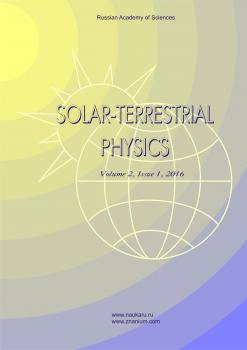Yakutsk, Russian Federation
The work uses data on the geomagnetic index Dst for the period 1966–2015. Under quiet conditions, the occurrence of seasonal variations of the daily average Dst index depends on geometric factors of the interaction between the solar wind and the magnetosphere; and under disturbed conditions, on the development of a partial ring current in the magnetosphere. At large negative values of the Dst index, there is no seasonal variation in it. The imperfection of the network of Dst stations is assumed to lead to the formation of annual variation in Dst. The formation of a semiannual variation is associated with the movement of the plasma sheet relative to the plane of the geomagnetic equator during the annual rotation of Earth around the Sun. Based on the data on semiannual variations in the number of days n(Dst), the critical daily average value of the geomagnetic index Dst is determined, starting from which we can speak of disturbed days: Dst≤–24 nT.
geomagnetic index Dst, semiannual variation of magnetic activity
1. Bartels J. Terrestrial magnetic activity and its relations to solar phenomena. Terrestrial Magnetism and Atmospheric Electricity. 1932, vol. 37, iss. 1, pp. 1-52.
2. Chen H.-F. Analysis of the diurnal and semiannual variations of Dst index at different activity levels. J. Geophys. Res. 2004, vol. 109, A03212. DOI:https://doi.org/10.1029/2003JA009981.
3. Cliver E.W., Kamide Y., Ling A.G. Mountains versus valleys: Semiannual variation of geomagnetic activity. J. Geophys. Res. 2000, vol. 105, iss. A2, pp. 2413-2424. DOI: 10.1029/ 1999JA900439.
4. Cliver E.W., Kamide Y., Ling A.G., Yokoyama N. Semiannual variation of the geomagnetic Dst index: Evidence for a dominant nonstorm component. J. Geophys. Res. 2001, vol. 106, iss. A10, pp. 21297-21304. DOI:https://doi.org/10.1029/2000JA000358.
5. Cortie A.L. Sun-spots and terrestrial magnetic phenomena 1898-1911: The cause of the annual variation of magnetic disturbances. Mon. Not. Roy. Astron. Soc. 1912, vol. 73, pp. 52-60. DOI:https://doi.org/10.1093/mnras/73.1.52.
6. Danilov A.A., Makarov G.A. Sector structure of IMF and ring current in magnetosphere. Fizicheskie protsessy v okolozemnoi plazme [Physical processes in near-Earth plasma], Yakutsk, 1984, pp. 28-40. (In Russian).
7. Danilov A.A., Makarov G.A. On the effect of the distribution of geomagnetic observatories on diurnal and seasonal variations of the Dst-index. Magnitosfernye issledovaniya [Magnetospheric research], Moscow, 1992, no. 18, pp. 125-129. (In Russian).
8. Danilov A.A., Makarov G.A. Dependence of magnetic activity on the plasma sheet location relative to the geomagnetic equator. Geomagnetism and Aeronomy. 2006, vol. 46, iss. 2, pp. 159-165. DOI:https://doi.org/10.1134/S0016793206020046.
9. Gonzalez W.D., Joselin J.A., Kamide Y., Kroehl H.W., Rostoker G., Tsurutani B.T., Vasyliunas V.M. What is a geomagnetic storm? J. Geophys. Res. 1994, vol. 99, iss. A4, pp. 5771-5792. DOI:https://doi.org/10.1029/93JA02867.
10. Hakkinen L.V.T., Pulkkinen T.I., Pirjola R.J., Nevanlinna H., Tanskanen E.I., Turner N.E. Seasonal and diurnal variation of geomagnetic activity: Revised Dst versus external drivers. J. Geophys. Res. 2003, vol. 108, iss. A2, 1060. DOI: 10.1029/ 2002JA009428.
11. Liu B.J., Zhang X.X, He F. Tilt of the ring current during the main phases of intense geomagnetic storms. Science China. Technological Sciences. 2019, vol. 62, iss. 5, pp. 820-828. DOI:https://doi.org/10.1007/s11431-018-9344-5.
12. Loewe C.A., Prolss G.W. Classification and mean behavior of magnetic storms. J. Geophys. Res. 1997, vol. 102, iss. A7, pp. 14209-14213. DOI:https://doi.org/10.1029/96JA04020/
13. Malin S.R.C., Isikara A.M. Annual variation of the geomagnetic field. Geophys. J. R. Astron. Soc. 1976, vol. 47, pp. 445-457. DOI:https://doi.org/10.1111/j.1365-246X.1976.tb07096.x.
14. Mayaud P.N. The annual and daily variations of the Dst index. Geophys. J. R. Astron. Soc. 1978, vol. 55, pp. 193-201. DOI:https://doi.org/10.1111/j.1365-246X.1978.tb04757.x.
15. Murayama T. Origin of the semiannual variation of geomagnetic Kp indices. J. Geophys. Res. 1974, vol. 79, iss. 1, pp. 297-300. DOI:https://doi.org/10.1029/JA079i001p00297.
16. Mursula K., Karinen A. Explaining and correcting the excessive semiannual variation in the Dst index. Geophys. Res. Lett. 2005, vol. 32, L14107. DOI:https://doi.org/10.1029/2005GL023132.
17. Petrukovich A.A., Zakharov M.Y. ap-index solar wind driving function and its semiannual variations. Ann. Geophys. 2007, vol. 25, iss. 7, pp. 1465-1469. DOI:https://doi.org/10.5194/angeo-25-1465-2007/
18. Russell C.T., McPherron R.L. Semiannual variation of geomagnetic activity. J. Geophys. Res. 1973, vol. 78, iss. 1, pp. 92-108. DOI:https://doi.org/10.1029/JA078i001p00092.
19. Simon P.A., Legrand J.-P. Solar cycle and geomagnetic activity: A review for geophysicists. Part II: The solar sources of geomagnetic activity and their links with sunspot cycle activity. Ann. Geophys. 1989, vol. 7, iss. 6, pp. 57-594.
20. Sugiura M., Kamei T. Equatorial Dst index 1957-1986. IAGA Bull. 1991, no. 40, pp. 7-14.
21. Svalgaard L., Cliver E.W., Ling A.G. The semiannual variation of great geomagnetic storms. Geophys. Res. Lett. 2002, vol. 29, iss. 16, 1765. DOI:https://doi.org/10.1029/2001GL014145.
22. Takalo J., Mursula K. A model for the diurnal universal time variation of the Dst index. J. Geophys. Res. 2001, vol. 106, iss. A6, pp. 10905-10921. DOI:https://doi.org/10.1029/2000JA000231.
23. URL: http://wdc.kugi.kyoto-u.ac.jp (accessed June 5, 2020).

















